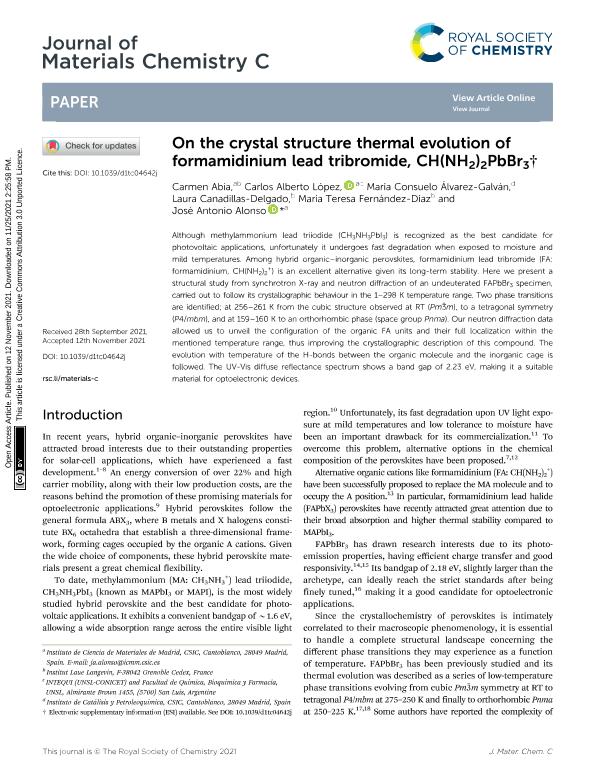Artículo
On the crystal structure thermal evolution of formamidinium lead tribromide, CH(NH2)2PbBr3
Abia, Carmen; Lopez, Carlos Alberto ; Álvarez Galván, María Consuelo; Canadillas Delgado, Laura; Fernández Díaz, María Teresa; Alonso, José Antonio
; Álvarez Galván, María Consuelo; Canadillas Delgado, Laura; Fernández Díaz, María Teresa; Alonso, José Antonio
 ; Álvarez Galván, María Consuelo; Canadillas Delgado, Laura; Fernández Díaz, María Teresa; Alonso, José Antonio
; Álvarez Galván, María Consuelo; Canadillas Delgado, Laura; Fernández Díaz, María Teresa; Alonso, José Antonio
Fecha de publicación:
11/2021
Editorial:
Royal Society of Chemistry
Revista:
Journal of Materials Chemistry C
ISSN:
2050-7534
e-ISSN:
2050-7526
Idioma:
Inglés
Tipo de recurso:
Artículo publicado
Clasificación temática:
Resumen
Although methylammonium lead triiodide (CH3NH3PbI3) is recognized as the best candidate for photovoltaic applications, unfortunately it undergoes fast degradation when exposed to moisture and mild temperatures. Among hybrid organic-inorganic perovskites, formamidinium lead tribromide (FA: formamidinium, CH(NH2)2+) is an excellent alternative given its long-term stability. Here we present a structural study from synchrotron X-ray and neutron diffraction of an undeuterated FAPbBr3 specimen, carried out to follow its crystallographic behaviour in the 1-298 K temperature range. Two phase transitions are identified; at 256-261 K from the cubic structure observed at RT (Pm3m), to a tetragonal symmetry (P4/mbm), and at 159-160 K to an orthorhombic phase (space group Pnma). Our neutron diffraction data allowed us to unveil the configuration of the organic FA units and their full localization within the mentioned temperature range, thus improving the crystallographic description of this compound. The evolution with temperature of the H-bonds between the organic molecule and the inorganic cage is followed. The UV-Vis diffuse reflectance spectrum shows a band gap of 2.23 eV, making it a suitable material for optoelectronic devices.
Palabras clave:
CH3NH3PbI3
Archivos asociados
Licencia
Identificadores
Colecciones
Articulos(INTEQUI)
Articulos de INST. DE INVEST. EN TECNOLOGIA QUIMICA
Articulos de INST. DE INVEST. EN TECNOLOGIA QUIMICA
Citación
Abia, Carmen; Lopez, Carlos Alberto; Álvarez Galván, María Consuelo; Canadillas Delgado, Laura; Fernández Díaz, María Teresa; et al.; On the crystal structure thermal evolution of formamidinium lead tribromide, CH(NH2)2PbBr3; Royal Society of Chemistry; Journal of Materials Chemistry C; 9; 47; 11-2021; 17003-17011
Compartir
Altmétricas



